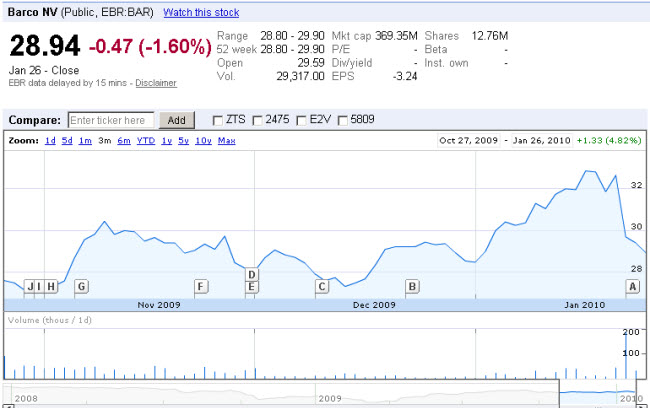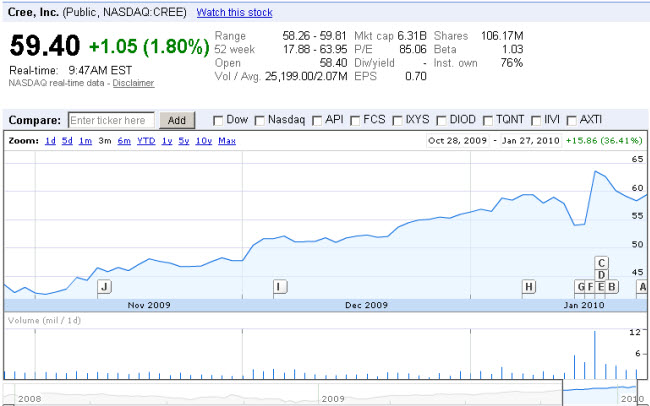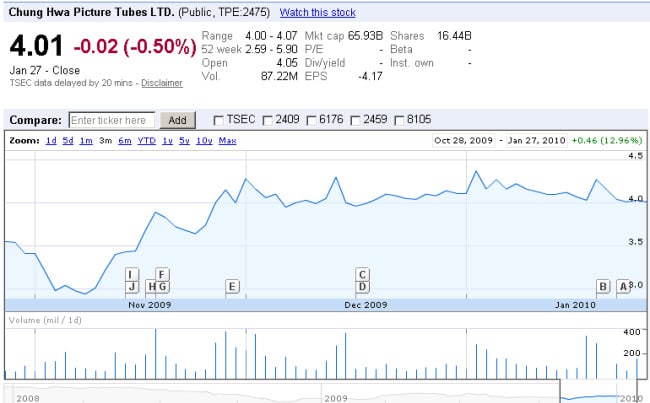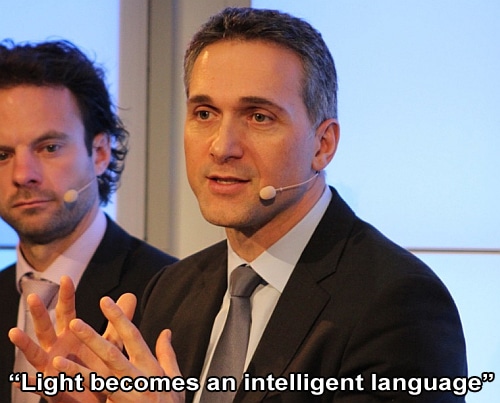
Something hilarious happened to me last week – well, hilarious to me. I was watching the news early in the morning, and as I flipped through the various new sources it was literally “the stock market” this, and “the blue chips” that, and “Main street took another hit today.” Oh – and JP Morgan irked the United States a few weeks ago when it unveiled its plans for high pay and big bonuses. Again.
I could not help but thinking that no one talks about lighting industries’ stocks. We provide the world with the ability to light up the darkness – we bring innovation to innovation. While people in our industry lose their jobs one after the other and stimulus money gets tossed into projects across the nation, don’t you wonder how the companies IN our industry are doing?
I captured some 90-day stock market charts last week for a handful of companies in the lighting markets. Obviously this is not an exhaustive list – if there are stocks you follow that you think I should be following, will you either post a comment below or send me a comment through the contact form? Pretty please?
Okay, let’s start out with Barco (Barco NV – BAR):
On January 26, 2010, Barco’s stock closed out at $28.94 per share, down 47 cents (or -1.6%). Barco’s market cap is $369.35 million – “market cap” or market capitalization is a number that represents a corporation’s outstanding number of shares multiplied by their price. What this means is that Barco has 12,760,000 shares of stock, each valued at around $28.94 each. Multiply $28.94 X 12,760,000 and you get around $369,350,000, their current market cap.
Something that strikes me as a bit sad, whether it is related or not, is when you put news against the market reports. For example, look at their stock price around the beginning of December, right when they laid off a bunch of High End Systems workers.
Look at Lighting Science Group – a company that engineers and makes LED products (Lighting Science Group Corporation – LSGC):
LSGC’s stock as of 1/26 was at 88 cents per share, with 30,460,000 shares outstanding – giving LSGC a market cap of $25,890,000 (remember, shares X cost = market cap). That share cost was up 3 cents (or 3.53%). For those of you following the news, LSGC announced at the beginning of the month that they were taking on Zachary Gibler, Carlos Gutierrez, Michael Kempner, Joe Montana and Michael Moseley to their board of directors. You might recognize Carlos Guitierrez as a CNBC news contributor and Commerce Secretary under George W. Bush. And yes, Joe Montana is THE Joe Montana, the football guy.
LSGC just this last week announced that they were commencing a rights offering for up to about 25 million Series D shares of non-convertible preferred stock (and warrants), which represents the right to purchase up to about 25 million shares of common stock. All of these terms are extremely confusing to people (like myself) who don’t follow the market nose first. LSGC’s Securities and Exchange Commission filings on this news are here.
You might be asking yourself, “What on earth are “Series D Non-Convertible Stocks?” Preferred stocks are debt instruments (like all stocks) that have a higher payout priority than common stocks. This means that dividends must be paid to preferred stock holders first before common stock dividend payouts. In the case of these stocks, the holders don’t have the option to convert them to common stocks, and preferred stocks normally don’t have voting rights. It’s all very complicated in my humble opinion.
Now look at General Electric (General Electric Company, GE):
GE has not had that great of a time lately as far as the stock market is concerned. As of January 26, their stock was down 6 cents at $16.29, and they were having one of the worst periods in their almost 120 year history. GE lost its AAA credit rating last year, and its GE Capital division ain’t doing so well – their commercial real estate division is getting hammered with vacancies and all that kind of real estate crap. GE is a HUGE company though – their market share is 173.48 billion – that’s $173,480,000,000 – with 10,650,000,000 shares outstanding at about $16.29 a share. That’s a lot of zeros.
Let’s move on to a company that people are hoping will do some amazing things with their Electron-Stimulated Luminescence technology, or ESL – the VU1 Corporation (VUOC):
VU1 is actually up 5 cents from the time I polled these numbers – but as of January 26 it was at $0.49 a share, with almost 86 million shares outstanding. Their market cap was $42,050,000 approximately, and they were down about a dime a share last quarter. The ESL technology is interesting, and on the VU1 blog there is talk of progress on an ESL replacement for the typical fluorescent tube.
Ok, now look at semiconductor manufacturer Cree, Inc (CREE):
Cree is having a great time right now – their stock price is up over 10 bucks since October 2009, and set a new record for the company’s stock prices on January 19, 2010. They’re actually down 2 bucks since January 26 when I pulled this report, but they’re still kicking some tail. With 106 million shares at around 60 bucks is giving Cree a market cap of 6.31 billion dollars – $6,310,000,000. I love to actually type out the digits, it really gives you perspective.
I wish I had a few extra buckaroos to invest, because I’d probably toss some of it into Cree stock. Analysts are flipping out over Cree’s prices and growth. I hope their growth spawns new and excellent technologies that are positive advancements towards our growth as an industry and not just the same old stuff for more money.
Some news I did not expect to hear lately was the agreement that one of their competitors Arrow Electronics signed with Cree to provide Arrow’s customers with Cree power products (Silicon Carbide JBS). Go, Cree!
The last company I want to actually talk about is Philips (Koninklijke Philips Electronics NV – PHG):
From when I pulled this report, Philips’ stock is down a buck or so per share. Philips is another enormous company with so many divisions – they have almost a billion shares of stock outstanding – 927,460,000 shares. Their market cap (927.46 million shares at around 30 bucks a share) is $29.17 billion dollars. Huge.
Philips is a monster in the LED business, and if you’re in the lighting industry you’ve heard of their LumiLED products. TIME Magazine gave Philips the honor of calling their LED replacement lamp as one of the best inventions of 2009, and people rave about their other product lines – LED wash fixtures, high output LEDs, and their various lines of consumer non-LED products, including incandescent and fluorescent products. They’re an industry leader.
None of this stuff is easy to understand, and believe me – I’m a lighting designer, not a market analyst. But it doesn’t take a Merrill Lynch quant to break down the major components into understandable pieces. I kinda look at it like this – when more people understand what is going on with a subject, it becomes that much more difficult for insiders in that industry to screw the public over. If I can help make that happen even a little bit, then we have collectively made an investment in our future and success.
I’m not gonna talk about the reports below, but they’re just graphs of some other companies’ stocks that I follow. If you have suggestions of companies I should watch, drop me a line or comment below, will ya?
Tatsuta Electric Wire and Cable – HOLY CRAP – $14.15 billion dollar market cap (for only 65 million shares), and their stock is at $217 a SHARE!
Chung Wa Picture Tubes:
Molex Inc – everybody knows Molex, right?













